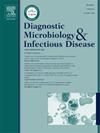Development of a real-time polymerase chain reaction (RT-PCR) assay for simultaneous detection of Helicobacter pylori infection and genetic mutations associated with clarithromycin resistance: A single-center, cross-sectional study from Singapore
IF 1.8
4区 医学
Q3 INFECTIOUS DISEASES
Diagnostic microbiology and infectious disease
Pub Date : 2025-09-28
DOI:10.1016/j.diagmicrobio.2025.117131
引用次数: 0
Abstract
Purpose
Accurate diagnosis of Helicobacter pylori (H. pylori), including detection of clarithromycin (CAM) resistance, is important for successful disease management. This study aimed to develop a real-time PCR assay that can simultaneously detect H. pylori infection and screen for point mutations in the 23S rRNA gene responsible for CAM resistance.
Methodology
A probe-based assay based on fluorescence melting curve analysis (FMCA) was developed and evaluated in this study. Primers flanking a 173 bp region of the 23S rRNA gene were used for the target amplification. The probe was designed to cross over the mutation hotspots, e.g. A2142G, A2143G, to detect point mutations in the melting stage.
Results
A total of 410 gastric tissue biopsies were cultured for H. pylori and concurrently tested by the PCR assay. Among these samples, 407 samples had a valid PCR result. 270 confirmed samples were H. pylori-positive by both PCR and culture. 113 samples were H. pylori-negative by both PCR and culture, and 24 samples were H. pylori-positive by PCR but negative by culture. For susceptibility testing, genotypic results were compared with phenotypic results. In the phenotypic CAM-susceptible group (n = 197), PCR FMCA correctly categorised 95.4 % (n = 188) of the samples into CAM-susceptible genotype. In the phenotypic CAM-resistant group (n = 64), PCR FMCA correctly classified 56 samples as CAM-resistant genotype, equal to 87.5 % accuracy.
Conclusions
This PCR assay provides an accurate method to detect H. pylori infection and simultaneously detect mutations in the 23S rRNA gene that are associated with CAM resistance.
实时聚合酶链反应(RT-PCR)检测同时检测幽门螺杆菌感染和与克拉霉素耐药相关的基因突变:新加坡的一项单中心横断面研究
目的准确诊断幽门螺杆菌(Helicobacter pylori, H. pylori),包括检测克拉霉素(clarithromycin, CAM)耐药性,对成功进行疾病管理具有重要意义。本研究旨在建立一种实时PCR检测方法,可以同时检测幽门螺杆菌感染并筛选导致CAM耐药的23S rRNA基因点突变。方法建立了一种基于探针的荧光熔化曲线分析(FMCA)方法。引物位于23S rRNA基因的173 bp区域两侧,用于目标扩增。探针被设计为跨越突变热点,如A2142G, A2143G,以检测熔化阶段的点突变。结果410份胃组织活检标本培养幽门螺杆菌,并进行PCR检测。其中407份样品的PCR结果有效。270份确诊样本经PCR和培养均为幽门螺旋杆菌阳性。113份样品PCR和培养均为幽门螺杆菌阴性,24份样品PCR阳性,培养阴性。在药敏试验中,将基因型结果与表型结果进行比较。在表型cam易感组(n = 197)中,PCR FMCA正确地将95.4% (n = 188)的样本分类为cam易感基因型。在表型cam耐药组(n = 64)中,PCR FMCA正确地将56份样本分类为cam耐药基因型,准确率为87.5%。结论该方法可准确检测幽门螺杆菌感染,同时检测与CAM耐药相关的23S rRNA基因突变。
本文章由计算机程序翻译,如有差异,请以英文原文为准。
求助全文
约1分钟内获得全文
求助全文
来源期刊
CiteScore
5.30
自引率
3.40%
发文量
149
审稿时长
56 days
期刊介绍:
Diagnostic Microbiology and Infectious Disease keeps you informed of the latest developments in clinical microbiology and the diagnosis and treatment of infectious diseases. Packed with rigorously peer-reviewed articles and studies in bacteriology, immunology, immunoserology, infectious diseases, mycology, parasitology, and virology, the journal examines new procedures, unusual cases, controversial issues, and important new literature. Diagnostic Microbiology and Infectious Disease distinguished independent editorial board, consisting of experts from many medical specialties, ensures you extensive and authoritative coverage.

 求助内容:
求助内容: 应助结果提醒方式:
应助结果提醒方式:


